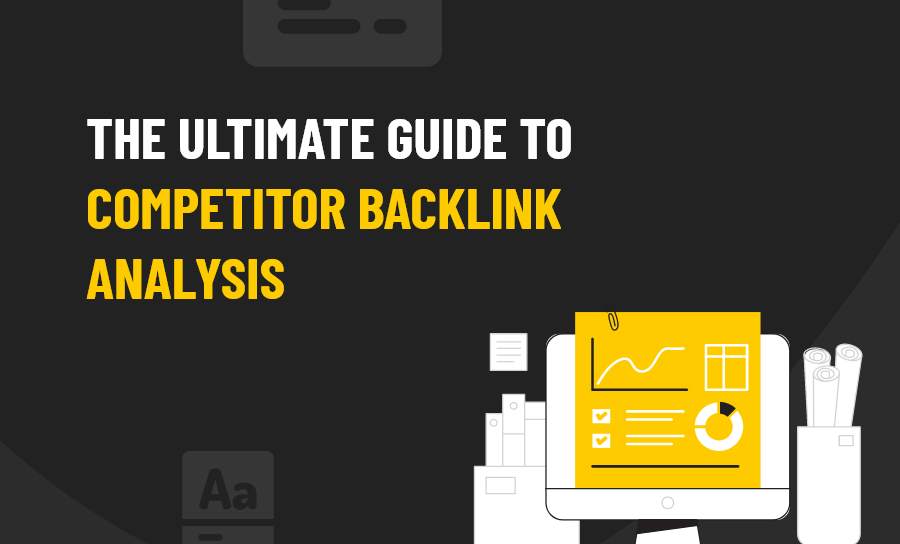Ok, so cards on the table; ‘CBA’ might not mean what you thought it did.
We like to use the acronym to refer to competitor backlink analysis. But you might find yourself even asking what that is.
If you want to improve your site’s rankings, one of the most surefire ways to do so is to gain backlinks. Sounds simple right?
Pick up a few links from a few high-quality sites and Bob’s your uncle. If only it were that simple. Competitor backlink analysis is the best way to get your foot in the door.
By analysing the links that your best-performing competitors have, you can strategise how to get the same (or similar) links). Conducting proper competitor backlink analysis takes a few tools, a bit of know-how and a fair bit of time.
The underlying secret, however, is that you need to be proactive. So we don’t want to hear any cries of ‘CBA’ when we’re teaching you about CBA in our ultimate guide!
If that’s agreeable, then let’s crack on with our ultimate guide to competitor backlink analysis.
Useful Terms
In this ultimate guide, we’re going to be using a lot of ‘SEO terms’.
There might be some that you’re familiar with, or this might be a new field for you. Either way, it will serve us well to put some definitions here before we move on.
Competitor Backlink Analysis (CBA)
Let’s start with the big one – CBA. Competitor backlink analysis is the process of looking at competitor sites and their backlink profiles.
By looking at how competitors in your niche are building authority by picking up backlinks, you can focus your link-building efforts. This guide will explain how to do that.
SERPs
Search engine results pages (SERPs) are the responses thrown up when you input a query into a search engine.
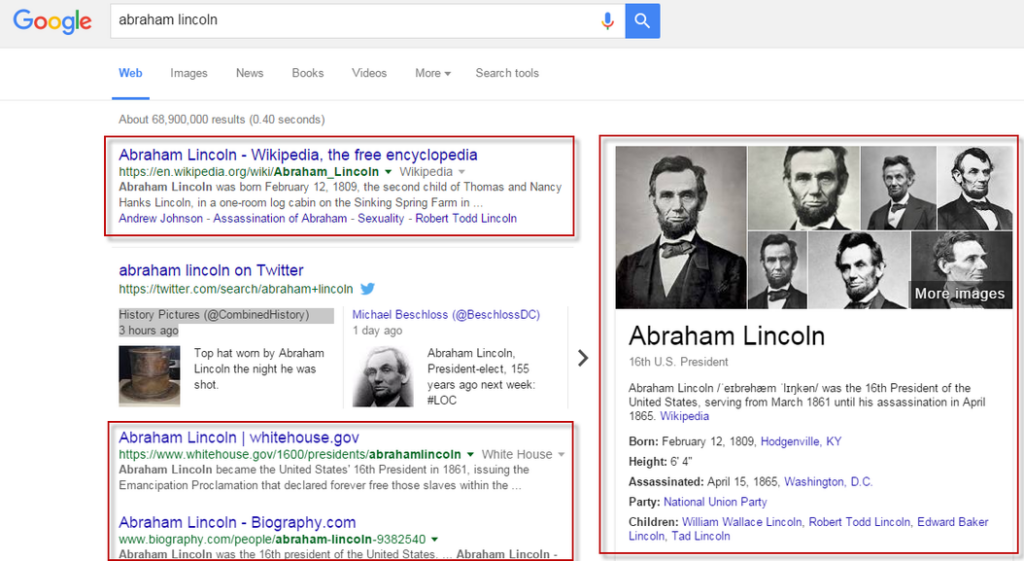
SEO
Search engine optimisation (SEO) is the process of improving the quality and quantity of unpaid traffic to your website.
Competitor
Your competitor is anyone who your business is in direct competition with. This could be for personal reasons or because you offer the same products/services.
We’ll explain in more detail later in this guide how your competitors in SEO-terms might not be who you think.

PageRank
PageRank is Google’s algorithm designed to rank web pages in their SERPs. It works by counting the number and quality of links to a page to gauge importance.
Anchor Text
Anchor text is the visible, clickable text that shows up when there is a hyperlink.
Link
A shorter term for hyperlink. A link is either a full or shortened URL (or one displaying custom ‘anchor text’).
Sitewide Link
A sitewide link is one that points back to a single URL but does so on every page of a site. For example, a sitewide link might appear in the site’s footer for the website building tool they used.

This is important to note because you will want to filter out these links when “prospecting” (looking for links that you want to earn).
404 Page
Play around with your perspective. Instead of focusing on how your business should be presented, think about how you would like for it to be found.
Think about what your potential client would be looking for as they Google away on their computer or phone.
For example, if you describe yourself as a “painter”, your target audience may be looking up the term “artist” more often on search engines.
Backlink
Similar to a simple link. A backlink is a link from one website back to the ‘quoted’ resource.
Backlink analysis
Backlink analysis is a way of looking at the data of all of your (or a competitor’s) backlinks. These are what Google takes into account as ranking factors and will determine your position in SERPs.
Link Prospecting
Apart from being a free SEO tool, Google Keyword Tool is owned by – Google. The only condition for using the tool is to run an AdWords campaign on Google.
However, if you want to set up an AdWords campaign, you can then use the Keyword Tool to access monthly search numbers for a specific term. You can do this nationwide, in your state, or even in your city.
Outreach

We will look in-depth at outreach later in this guide. For now, just know that it’s the part of the process that comes after prospecting and is usually done by email.
Outreach will be the stage of the campaign where you’re reaching out to people, offering them your new or superior content in exchange for a link.
Competitor Backlink Analysis (CBA)
We’re not sure if anyone else in the world of SEO actually shortens it to CBA, but heck, we will!
So if you find yourself further into our ultimate guide and wondering if we’ve just given up, have no fear. CBA means competitor backlink analysis. This refers to the data gathering and prospecting phase of competitor link-building.
Like we mentioned previously with backlink analysis, CBA will show you all of your competitor’s backlinks.
Link building
Link building refers to the process of making steps to gain links from the sources that you’ve prospected. In turn, higher volumes and quality of inbound links can increase your traffic and rankings.
Dofollow/No follow Link
We’ll keep these definitions simple. Ultimately, a nofollow link is one that Google ignores for ranking purposes. They can still be very useful, however, depending on where the link comes from.
A dofollow link, on the other hand, is one that search engine bots and people can ‘follow’. Because of this, they can help increase your ranking, among other things.

Domain Rating/Domain Authority
Domain Rating (Ahrefs) and domain authority (Moz) are different ranking scores used by tools to predict a page’s ability to rank.
A high DR score indicates that a website has a solid backlink profile. Again, this can be judged relative to the site and niche.
For example, if your site has a DR of 30, and your competitor has a DR of 90; they’re not even your competitor!
A good DR would probably be between 40-60 but will depend on your niche and how new your site is.
URL Rating
This is a rating provided by the tool Ahrefs which shows the strength of a page’s link profile on a 0-100 scale. The higher the number, the stronger a page’s link profile.
Referring Domains
This is the number of websites that contain a link back to your page. This refers to entire domains.
A high number of referring domains could indicate a strong site, as long as the links aren’t low-quality. It’s useful to look at referring domains alongside DR. Then, you can get a sense of the quality and quantity of links to a site.
Plus, the more links you have from one domain, the lower their power when it comes to ranking.
This is why it’s important to get links from new websites rather than ones that already link to your site.
White Hat/Black Hat SEO
Black hat SEO refers to disapproved, or ‘spammy’ practises to gain quick fixes to page ranking. They can incur penalties and even bans and are generally frowned upon.
On the other hand, white hat SEO practises are seen as more ethical. They use techniques and strategies that target human audiences.
Penguin Update
Google’s 2012 Penguin update cracked down on sites that were spamming search results. This was often through buying links or gaining links through dodgy link networks.
Link equity
Link equity or ‘link juice’ is a ranking factor based on the idea that links pass value and authority between pages.

CSV
A comma-separated values file (or CSV) is what we typically call an Excel spreadsheet. This will be a useful abbreviation later in this guide when we’re talking about collecting data.
Crawled/Crawling
Website crawling is the automated fetching of web pages by a software process. The purpose of this is to index the content of websites so they can be searched.
Well done for getting through all that!
Now that we’ve either learned or refreshed those definitions in our minds, we can move on. If you have struggled through the boring part, though, you might be asking yourself:
Why Bother?
There are a lot of good reasons to conduct regular backlink analysis, whether it’s on your site or your competitor’s.
For your own benefit, backlink analysis can be important for you to see if you have spammy backlinks. Your ranking efforts might be affected if you have a bunch of backlinks from less than reputable sites.

You can even use backlink analysis to regain your lost links. You can reach out to post authors or site masters and ask why your link was removed. Then you can see if there’s anything you can do to improve or change the content that the links references.
On the other hand, the reasons as to why you might want to look at your competitor’s backlink profile are:
To find their weakness and capitalise Or To find their strengths and replicate.
Overall, it’s unavoidable that backlinks are still one of Google’s top 3 ranking factors. You can’t afford not to put some effort into investigating yours and your competitor’s.
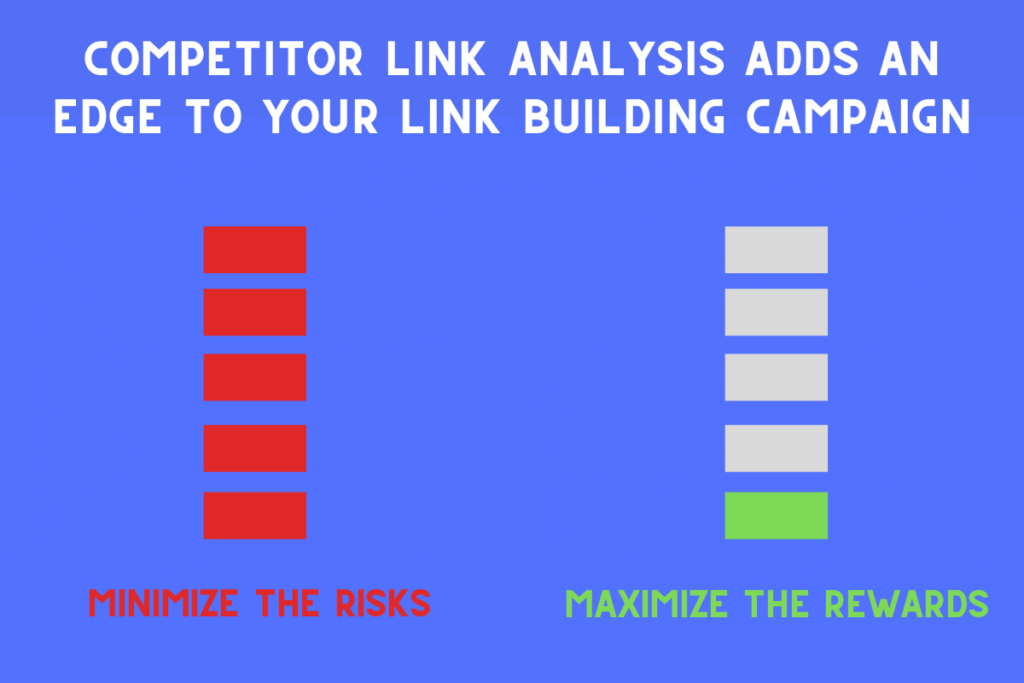
Think about a recent study by Ahrefs. Ahrefs crawled one billion pages (yes, you read that right!). And what did they find?
90.63% of all those pages got zero traffic from Google!
So, why is that? If backlinks are one of the top 3 ranking factors and, yet, most pages get zero traffic from Google…are you starting to see our point?
Do you want to be among the top-ranking pages and direct people to your product or service? Then you need to focus on your backlink profile and CBA.
Normal Ways To Create Backlinks
For now, let’s have a look at how you might normally go about getting links.
In theory, anyone can get backlinks. In practice, however, it’s much harder to do. Without a proper framework like CBA, you might end up getting backlinks from irrelevant or even harmful sources.
You could, for example, get yourself listed on a bunch of online directories. This could be useful for small, local businesses, but it isn’t going to improve your SEO much.
You could even think about buying links for a quick boost. However, in a 2016 study, the average price of a link was $352.92. And, at the end of the day you can’t always determine the quality of the link you’ll be getting.
Think about the effect that your backlinks are going to have on your SEO. Then, think about how your SEO can affect your ranking. This will determine how many people see or find your product/service with direct implications for your revenue stream.
Which is why, in this ultimate guide, we advocate for a smarter approach to building backlinks. And that approach is called CBA.

What Is Competitor Backlink Analysis (CBA)?
As good as your backlink profile and your ranking efforts are, they could always be better.
With the framework of CBA, you can ask yourself: if my competitor is getting mentioned, why aren’t I?
There are a couple of distinct strategies we’ll be looking at when talking about what to do with the data that you get from CBA.
There are probably loads of ways that you can create insights from this data. But we’ll be focusing on: competitor link building and broken link building.
As we mentioned earlier, by looking at your competitor’s backlink profile, you can figure out what they’re doing that you’re not. In turn, this should tell you what you need to be doing.
You can conduct CBA on your competitors, or even more generally for what sites are ranking on page 1 in your niche.
The thing with link building as a strategy is that it’s hard. So one of the best places to start is with CBA.
In this guide, we’ll explain how to start with your competitors so that you can copy what works for them and then reverse engineer it.
When looking at your competitor’s mentions, bear in mind these questions:
- Does the link look natural?
- Does the anchor text fit the nature of the link?
- Is the link helpful?
- Is the link relevant?
If the answer is yes, you can think about how to replicate how your competitor got that link.
If the answer is no, then think about what you can offer to improve (or even ‘steal’) the link on the site where it appears.

What Does A Good Link Look Like?
So just before we dive into how to get those juicy links, let’s recap some factors to look at. When prospecting for link opportunities, remember that we said just any old link won’t do.
Some factors to look at before we move on might be:
- Does the site have a high domain authority (DA)/domain rating (DR)?
- Is the site relevant to your niche?
- Has the site been live for a minimum of 2 years?
These are all factors when trying to acquire links that will help separate the wheat from the chaff.
How Do You Get Links?
In a moment, we’ll be looking at a step-by-step guide of how to conduct competitor backlink analysis.
But even before we get into that, you might likely have Googled your competitors. You might have even seen them pop up on some of the most popular sites in your shared niche.
You might be asking yourself:
- Did your competitor write a guest post on that site to get the backlink?
- Did the webmaster publish a product review about your competitor’s tool?
- Was your competitor a podcast guest?
If you want answers, then below we’ve outlined how you go about getting links.

Outreach
Outreach is usually conducted via email campaigns. It can be local-scale, e.g. getting your business added to those local directories where a local competitor appears. Or it can be on a much grander scale.
For CBA, the outreach phase will come once we’ve prospected and qualified where we want to get backlinks from.
Other places that you could get backlinks from might be:
Webinars
If you’re a thought leader in your industry or want to do a bit of authority marketing, it’s a good idea to host webinars.
You can either do this yourself or appear as a guest at an event. If it’s the latter, or if it’s at a university, there will likely be an accompanying write up. In this blog post, you might get (or can ask for) a link back to your site.
Events
This is similar to the webinar idea, whereby having your author byline featured can also include a link.
Podcasts
You might be wondering how you get a link from a podcast. The great thing about podcasts is that they’re not only useful for increasing your social proof and engagement.
A podcast will be posted to a streaming service. It might even have an accompanying video or video graphics on Youtube. If so, you can request that your site be placed in the description (great for SEO as well).
Guest Posts
Guest posts are one of the most popular ways to obtain backlinks. By targeting popular and well-respected blogs in your niche, you can find sites that might be happy for you to contribute a post.
You can then link back to your site in your author bio whilst cementing yourself as a thought leader in your niche.

Forum links
This one is a bit of a debatable tactic, but we’ve seen these valuable backlinks in client competitor analyses over and over again. You need to ask the question: what content attracts your competitor’s users?
Can you get backlinks in blogs that potential users frequently migrate to? These can have a much greater effect than struggling, for example, to get a backlink from Forbes (very hard!).
Infographics or Template Building
This strategy might not be applicable to your business. But one surefire way of getting backlinks is to create and shop around your visual content. These could be templates, infographics, or even memes.
Either way, you could think about offering a visual asset that’s useful for users or bloggers in your niche. Then you can get them to link back to your site in the accreditation.
But the process of finding your competitors, seeing where they have backlinks from, and outreaching to those sites can be tedious.
In fact, it’s almost impossible to talk about a framework and a strategy to conduct CBA without at least a couple of the tools we’re about to list below.

Software For CBA
When conducting competitor backlink analysis, we’re potentially going to be dealing with a lot of data. If you want to conduct the most widespread and comprehensive research to gain actionable insights, you’ll need some, if not all, or the tools below.
Excel Or Sheets
Excel is a desktop spreadsheet programme, whereas Sheets are the cloud-based G-suite version. Realistically, and for practicality, you could end up using both.
When we get a little further down on this list to talk about tools like Ahrefs and SEMrush, we’ll explain why you’ll need Excel.
Because you’ll be handling a lot of data, you’ll want to export results as CSV files. This will automatically download to Excel. At this point, you could continue working in Excel.
Although, for easy updating and sharing between your team, we recommend migrating to sheets. You can simply copy all the relevant data into Google Sheets and give your team access.
Ahrefs
Ahrefs is one of the most comprehensive but easy-to-use tools for SEOs (SEO professionals). It is the tool that we’ll be basing a lot of our explanations on later in this guide. So if you haven’t already, we urge you to go check it out here.
But back to what it can do for you when conducting CBA. With Ahrefs, you can input your (and your competitor’s) site and crawl it for the relevant data.
This will include things like the site’s backlink profile and the number of referring domains.
The great thing about Ahrefs is that it’s fairly simple to pick up (trust us) and has a clean-looking dashboard with graphs and score ratings. All of this makes for easy comparison and a user-friendly experience.

From there, you can get deeper into what Ahrefs can do for link analysis. You can even do cool stuff like compare similar pieces of content on your site versus your competitor’s.
Then you can look at something called ‘link intersect’. This is where the tool will look at sites that are linking to your competitor’s content but not yours. This then becomes one of the perfect starting points for competitor backlink analysis.
You can also mess around with filters (which we’ll get into in the step-by-step guide) to discern whether you should copy your competitors. Does their backlink profile look legit? Are there a bunch of historical dead links?
You can even get into the nitty-gritty of why your competitors did so well at a certain time.
You can do this by searching for their spikes in the number of backlinks that they gained. If there was a period with a particular spike, you could start investigating what they did to get there.
It might be something as simple as using a 301 link redirect to pass link equity.
This would be where you’re redirecting one URL to equivalent content. You don’t expect that content to come back to the original URL, but you do want to pass the link equity on.
If you want to get to grips with using Ahrefs, check out our ultimate guide.
SEMrush
Another useful tool for CBA would be SEMrush. You’ll probably find yourself using either SEMrush or Ahrefs, but they are both top-tier tools.
SEMrush is a fantastic all-in-one SEO platform and has a great link-building tool. It has a helpful user manual, and you can even connect it to your Google Search Console (GSC). This will allow you to analyse all your website’s data from SEMrush.
Like Ahrefs, SEMrush has helpful visuals on the dashboard with scores for DR and trust scores. They also have their own SEMrush score for sites ranked out of 5, which helps to organise results for ease.

Once you get round to the outreach stage for your competitor link campaign, you can also attach a mailbox. From there, you can pick your outreach strategy by type, and you’ll receive status updates.
Later in this guide, we’ll be giving you some useful email templates for CBA at the outreach stage. SEMrush also features templates and sequencing, which is super-handy!
Just remember that SEMrush does have a 500 email limit per day.
Buzzsumo
If you’re not using SEMrush, then Buzzsumo will be the perfect tool for the outreach stage of CBA.
After you’ve collected all the relevant data about your competitor’s links (don’t worry, we’ll show you how), you’ll want to start contacting people.
You can also find content by influencer or topic so that you can start replicating your competitor’s best practises.
Mailshake
Another option for automating the outreach phase would be Mailshake.
The great thing about Mailshake is that you can create separate campaigns and sequence emails with follow-ups.
This is great if you want to create separate outreach campaigns for each of your competitors.
Mailshake’s easy-to-use interface can make this whole process seamless and save you tons of time.

Hunter
Hunter is a practical tool that we’ll be referring to in the outreach phase. Once you’ve crawled your competitor’s sites to find where to get links from, you’ll need contact information.
Hunter works by scraping emails and contact information from sites. With that, you can get in touch with the right decision-makers about link-exchange.
Google Alerts
If you’re running a business, chances are you already have Google alerts linked up. You can set alerts regarding new content that goes live with mentions for specific topics.
This is useful for several reasons:
- You could be a well-recognised brand. But you might not be picking up on all the links you should. For example, know when someone writes about you but doesn’t link. Then you can reach out to them.
- You could use the strategy of topic takeover. By setting up alerts, you can be the first person to create content around breaking stories. Then, you can establish yourself as the authority (and top-ranking page) on that topic.
- For CBA, you could even set up mentions for your competitors. Then you could reach out to the people that are mentioning them.
Either way, Google alerts has many features that come in handy for CBA and link-building in general.
If you want to learn more about how to use Google Alerts for link opportunities, check out our guide here.
Linkody
Remember earlier when we said that backlink analysis can help you find links that you’ve lost? Well, Linkody can give you a comprehensive backlink profile – for you and your competitors.
There are also cool features like your anchor profile. This can tell you how you can revitalise links with diverse but natural brand keywords.
With Linkody you can centralise your link building (and CBA) campaign with easy-to-read data.
Archive.org
Archive.org’s Wayback tool will be useful when we look in more detail at broken link building. Once we’ve walked you through CBA, you can use Archive and Wayback to get the ball rolling on creating content.
Let’s say that you’ve run your CBA and found that your competitor has a lot of referring domains to a 404 page. Before reaching out to all the editors of those domains, you could use the Wayback tool.

By looking at what content was on the page, you can cut down on time spent creating unique content. Then, when you suggest a link replacement to all those referring domains, you’ll have something of value to offer!
Don’t worry; we’ll explain all of this in more detail.
What Can CBA Tell Me?
So now you’ve got the terms and the tools. But you might still be wondering what benefit conducting CBA can have for your business.
By running a CBA, you can find:
- Your competitor’s content gaps.
- Keywords that your competitor is ranking for.
- Your competitor’s most popular and most-linked-to content.
- Your and your competitor’s broken link profiles.
Then, you can think about:
- Creating and pitching content to replace your competitor’s links.
- Re-optimising some of your pages for different keywords.
- Where you need to have more of a presence in your niche.
Now, all we need to know is how to conduct a competitor backlink analysis.
Let’s dive into it.

Competitor Link Building
By starting with a competitor backlink analysis, we’re going to teach you two strategies that you can replicate.
With them, you can effectively outclass your competitors and pick up their old links with your new content. At the very least you can get similar links and rank alongside them.
These two strategies are competitor link building and broken link building. Both tactics start with a comprehensive competitor, backlink analysis.
Let’s start with the competitor link building.
Step-by-step Guide
Identify Your Competition
The first step is obviously to identify your competition. As we mentioned earlier, your competitors might not be who you think they are.
If you’re a local butcher, you might well think ‘Dave’s Meats’ just down the road is your hottest competition. But when conducting a competitor backlink analysis, Dave might have no online presence. He might not even be listed in local online directories.
This will mean that his business isn’t appearing in SERPs. For this reason, it’s important that we remember that we’re talking about backlink profiles and how they affect your SEO.
There are a number of different ways that you could search for your competitors. One method would be to get some more information on the people that you see as real-world competitors, like ‘Dave’s Meats’. But remember, the results might be disappointing.

Another way to start would be to build data from some simple Google searches. Using the structure below, you can quickly come up with lists of competitors.
For example:
Google: [niche] + [your product or service]
This might look something like:
Google: SEO agencies + Pearl Lemon
You could also do this for your whole domain, or look in SERPs for keywords to search by.
To find these keywords, conduct some more Google searches. See what keywords pop up. Or you could even use a plugin like Keywords Everywhere that will tell the search volumes of queries containing those keywords.
The important thing to remember is that, like with who you think your competitors might be, your ranking keywords might not be what you think.
Direct competition doesn’t always mean SEO competition!
A much more comprehensive (and we think easier) way to conduct this research would be with one of the tools that we mentioned. Personally, we recommend using Ahrefs for its ease of use.

Get Their Backlink Profile

So now that you’ve discovered who your competitors are, you’ll want to get some data on them. From this point out, we’ll be explaining to take these steps using Ahrefs. Although, it will be similar with other SEO tools.
To start, you simply input your competitor’s website url into the site explorer search bar.
You’ll then be presented with visual representations of your competitor’s SEO. This will include things like their DR with links in the dashboard to their backlink profile.

By clicking on the backlink profile tab, you’ll get a comprehensive list of everywhere on the internet that links back to that site. (For Dave’s, most of them were directories – we told you!).
Something interesting to note here is how you can leverage superfans in your competitor link building. If you see that your competitor has a lot of links from one source it might be worth pursuing.
Earlier, we said it’s better to pursue links from multiple new sites rather than ones you already have. If Dave’s Meats has a superfan, it won’t increase that link’s power just because they link back to his site a lot.
But you can take that link as a quick win. If you’re in a similar niche and you can see that that person is responsive, that’s an easy link to win. Then, you can also build an ongoing relationship with them.
Get Your Backlink Profile
It’s no use just looking at your competitor’s data in a vacuum. You need to understand how backlinks are working for your business too.
Repeat step 2, replacing your competitor’s URL for your site’s URL. Once you’ve had a look at these side-by-side, it’s time to collate all that data.
Export and Filter
Now that you’ve familiarized yourself with the dashboard, we can get on to exporting the necessary data.
To do this, we suggest taking these steps to get the most relevant results:
- Click on backlink profile to pull up your competitor’s backlinks.
- Click ‘one link per domain’ to filter out repetition like sitewide links.
- (Optional) Set ‘link type’ to ‘dofollow’ – These are links that are useful for ranking.
You can even segment your list further by changing options like ‘language type’ and ‘platform’. For example, you could use this if you only want to get links from bloggers that your competitor has backlinks from.

At this point, you’ll then want to filter your results by descending DR. This will give you the ‘best’, most trusted sources at the top of your list.
Putting in the work at this stage of prospecting will save you time in the outreach phase.
Once you have all these filters set up, you’re ready to export the data. Now you can choose how many rows you want to export. Although, with the filters, in place, you should be ready to extract everything.
This will then download as a CSV (Excel) file. At this point, you’ll want to repeat these steps for all your competitors as well as your own site.
You can then copy and paste this information into a Google Sheet or keep it in Excel. Here’s a useful template if you want to compare competitors in an Excel spreadsheet.
To set yourself up for quick wins, prospect and filter the links that you:
- Simply don’t want.
- Don’t think fit your niche/business.
- Already have.
From there, you can start building actionable insights.
Build Insights
CBA is all about finding out where your competitors are mentioned and why.
Once you’ve figured this out in steps 2, 3, and 4, you can think about how to get those links for yourself.
If, as is most likely, most of your competitor’s backlinks are coming from content, ask yourself these questions:
- What topics get linked back to a lot?
- What type of posts get linked back to? (Listicles, infographics, blog posts)
- Are there content gaps or trends that you can exploit?
Then you can start thinking about building a piece of content that’s either missing or is better than your competitor’s. This will put you in a good position when you come to the outreach phase to (ahem) steal their links!

With tools like Ahrefs, you can even combine your CBA with other tactics. For example, if your competitor has a lot of backlinks for a piece of content focusing on a particular keyword, where can you replicate it?
By having a look at the KD (keyword difficulty), you can start to build insights as to whether it’s worth trying to rank for.
It might also give you insights as to whether your competitor’s keywords might be better replicated on your homepage, or in a piece of content.
Let’s put a pin in that for now and show you how to set up your CBA spreadsheet.
Spreadsheet Template
Hopefully, you filtered the data as you went along as we suggested. However, you’ve still probably been left with unnecessary data.
By following the steps below, you can remove ‘bad links’ (low DR etc.) and organise your spreadsheet. This is especially useful if you exported all the data without applying filters.
For this example:
- Say that we’ve found our 5 top SEO competitors.
- We’ve conducted CBA on all of them.
- We’ve also got our own backlink profile (but we’ll keep this separate for a minute).
- We’ve exported the data to CSV files.
- Now we want to collate them all into one spreadsheet.
We might start by:
- Creating a Google Sheet.
- Naming it.
- Sharing it with the relevant members of our business for edit access.
- Wrapping all text.
- Widening columns and labelling them with DR, URL, Referring URL, and Link URL.
- You might even add columns for Link Type, Approach, and Status, ready for the outreach phase.
Have a look at our template below to see how you can set up your CBA sheet.
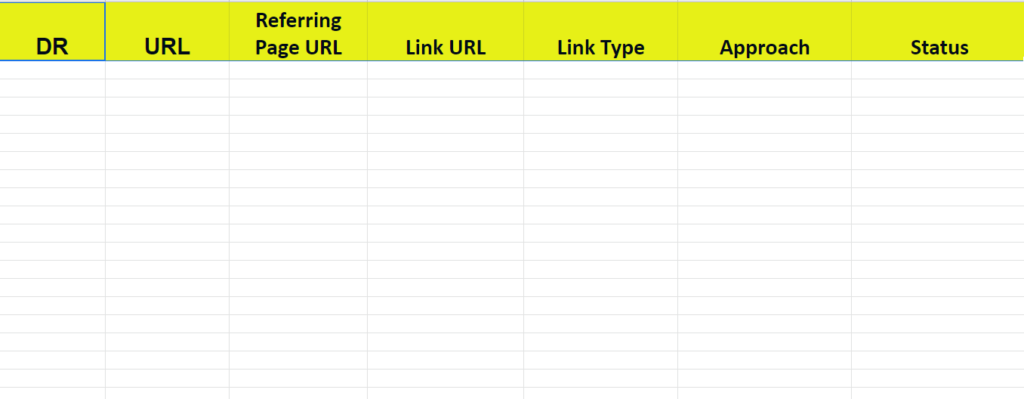
It’s going to be useful at this stage to cut down on the amount of data visible. This will help you visualise and organise the backlinks that you want to pursue.
For example, even with the filters that we applied, our data from Ahrefs might still look like this:

Within that spreadsheet, there’s a lot of potentially useful information. But for now, you only need to focus on the four areas that we mentioned:
- Domain Rating.
- The URL Rating (optional).
- The Referring Page URL (very important).
- The Original Link URL.
You will need these so that you can not only find who to reach out to but qualify whether it’s worth doing so.
So at this stage, we suggested that you delete all the columns in your sheet with unnecessary data.
These will probably include (just in case it’s not clear):
- #.
- Total backlinks.
- Referring domains.
- Referring page title.
- Internal and external links count.
- TextPre, anchor text, and TextPost.
- Type and status.
- Seen, checked, and lost.
- Language, traffic, and keywords.
You might find some of these useful when looking at your own site’s backlink profile, however. For example, seeing when a link was lost means that you can reach out to find out why.
For now, though, we only want to populate our sheet with the most important data. Once you’ve done this, it’s a good idea to sort your sheet by descending domain rating. Then, you’ll be left with the best (or most valuable) links at the top of your sheet.
You can do this by clicking on the top of the column with DR and sorting by descending values. You can then sort the whole sheet by this column if it doesn’t automatically update.
You can then choose to update this sheet with all your competitors’ backlinks or create a new sheet for each one.
Personally, we suggest the second approach to keep everything neat and separate.

What If You Didn’t Filter The Data?
If you didn’t filter the data, then please read this section before moving on to what to do with all that information.
If you did, and you’re happy with the results in your competitor backlink sheet, move on to the section on email templates.
To filter your data once you’ve exported it, follow the steps below. This will leave you with only quality links to pursue.
Remember, there’s no point chasing after your competitor’s links if they’re from low-quality sources.
First, open your sheet with only the relevant data left (DR, URL, Referring Page URL, Link URL). Then:
1. Select the column you want to create a filter for (DR).
2. Click on the ‘create new filter’ button.

3. To sort the column by values, first, click clear.
4. Then, manually reselect the values you don’t want to see. For DR this might be 0-39.

5. You will be left with only domain ratings of 0-39 in your sheet.
6. Now you need to select all the rows with values in them. (Make sure not to include your headers or it will delete your titles!).
7. Press delete and then turn off your filter to be left with links from domains with a 39+ rating.
That might all sound like a lot of work, but it’s a great way to build a clear and concise sheet to work with.
What you should see is that you’re left with only the highest quality links, sorted in descending order.
And from there, we can move on to the outreach stage, which is where you’ll start picking up those desirable links.
CBA Outreach Phase
Now that you have a list of your competitor’s backlinks and where they’re coming from, you want to go about getting them for yourself.
To do this, you might want to invest some time into figuring out what value they offered to that referring domain.
Earlier, we said that the point of CBA was to figure out if someone is mentioning your competitor and why they aren’t mentioning you.
Having some unique and informative content relevant to your niche is always a great proposition.
Next, you’ll have to visit the referring page URLs and use a tool like Hunter to crawl them for contact emails. Try to identify key-decisions makers or even the authors of the linking content.
Then, you can update your spreadsheet with this contact information.

This is why, earlier, we suggested including columns like ‘link type’, ‘approach’, and ‘status’ so you can track your campaign. You could also track this with a tool like SEMrush.
Filling in these columns will also help you to personalise your outreach campaign. In turn, this could result in a higher percentage of links gained.
These columns might look something like:
Link-type: Blog.
Approach: Offer them a guest post on {breaking topic} in my niche.
Status: A drop-down list of: ‘emailed’, ‘contact made’, ‘post submitted’.
Once you have all of this information, you can start to personalise your competitor link building campaigns.
Let’s have a look at a CBA email template that you can adjust to suit your needs.
Competitor Email Template
Subject: Exclusive: {niche}’s Best Kept Secret!
Hey {firstname} 😁,
I was reading your post, {postname} – and I noticed that you’d linked to {competitor name}.
The link appears {where in post}, around {quote before}. Here’s a screenshot if it’s easier:
{insert screenshot}
Our product/service, {name of your product/tool}, is similar to {competitorname}’s and I was wondering if you would add us to your post as an alternative.
The main difference between our tool and {competitorname}’s is that {highlight differences}.
We’ll even provide the necessary content to add to your post and promote it across our socials. Sound good?
No worries if you can’t do this at the moment. Maybe we can help with something else you’re working on? Let me know! 💪
Thanks for reading this and have a nice day!
Cheers,
{sendername}
{signature}
Feel free to use that template in your outreach. For now, let’s just break down what’s so great about it.

Template Explained
Earlier in this guide, we said that competitor backlinks analysis could be used to replicate what your competitors are doing well.
What better way to do that than to go after their most valuable backlinks and offer your product/service as an alternative?
There’s no love lost and (if you have a good value proposition) there’s no reason why that site won’t host your link too.
Let’s work through the elements of that email that make it stand out in an inbox.
First of all, the subject line is killer. It creates a sense of urgency and FOMO (fear out missing out) which has been proven to drive open rates.
The body of the email is also personalised and addresses the recipient directly. Using the personal data, you gathered in your prospecting stage; you can see better results in the outreach phase.
There’s a clear appreciation of the site/blog/author’s previous posts. The issue (your competitor’s backlink) is also clearly signposted with a screenshot and surrounding text.
This all revolves around making life easier for whoever you’re reaching out to. They’re much more likely to include your link if it makes sense and it’s easy for them to do.
That’s why highlighting the differences, providing the content, and promising to promote the post all make this email stick out.
Then, there’s a friendly sign-off that fishes for other opportunities without any hard feelings.
All in all? A pretty awesome email template to use in your competitor backlink analysis.

Once you’ve made templates for your outreach and follow-up, you can sequence them in tools like SEMrush or Mailshake.
From there, you can check on your success rates with emails opened, links clicked and ultimately, links gained.
So there you have it – a step-by-step guide to competitor backlink analysis to create a competitor link-building campaign.
But as we said earlier, this is just one way to use your competitor backlink analysis.
This first method relies on you co-existing on a referring domain that links to your competitor. On the other hand, you could always look at claiming your competitor’s broken links.
Broken Link Building
Broken link building is another effective strategy to use the data from your CBA.
You’ll remember that we said you could use your own backlink profile to reach out to places where you’ve lost links.
Well, you can use a similar strategy to look at your broken link profile. But for competitor backlink analysis, you can pick up and replace their broken links.
Let’s explain.
By looking at broken (or ‘404’ links) on your competitor’s page, you can easily reach out to whoever’s in charge of the referring domain. Then, offering them a value proposition is a pretty easy sell.
After all, if you can offer them some new content on a working page, it’s of great value to them and their users.
A broken link on your competitor’s site might occur when they have deleted a piece of content. If that content had a lot of other posts linking back to it, all those links are now useless. They can also be frustrating for users when clicked on.
If your competitors aren’t regularly crawling their own sites for broken links, you can do it for them!

This is a great competitor backlink analysis strategy to pick up some easy wins.
Let’s have a look at a step-by-step guide for broken link building.
Step-by-step Guide
To start, let’s jump back into our backlink tool (SEMrush, Linkody etc.). For this example, we’ll be using Ahrefs.
Get Broken Link Profile
We’ll assume that by this stage you’ve already identified your competitor/s as we taught you earlier.
To get their broken link profile for your CBA, input their landing page URL into Ahrefs.
From there you can either go directly to ‘broken links’ or navigate to ‘best by links’. Once there, change the HTTP code selection from the drop-down to ‘404 not found’.
What you’ll be left with is all the 404 pages on your competitor’s site.
This is important because you can go about finding out who’s linking to that broken content. Then, it’s a simple step to create an outreach campaign around it and start harvesting links.
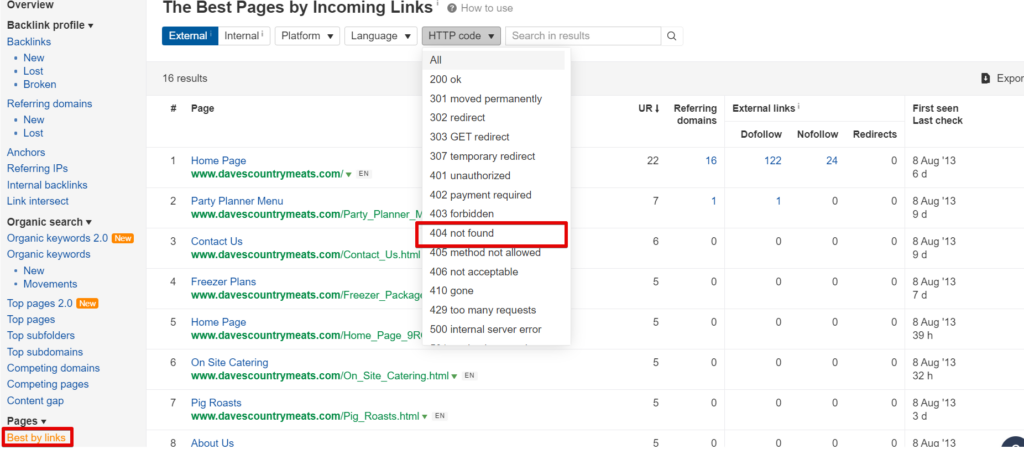
Export And Filter Data
Just like with the competitor link building strategy, you now want to filter and export the data. (And then filter it again!).
To do this, we suggest that you:
- Click ‘referring domains’ to sort your results with the highest number of referring domains at the top. This will give you the most valuable and linked-to content first.
- Filter links by ‘one per domain’ to remove repetition.
- (Optional) Filter for content with only dofollow links where there will be some link equity.
- (Optional) Only export the rows with three or more referring domains.
You will then be left with a new CSV file with the broken link profile of your competitor.
Tip: It is often useful (if you can spare the time) to also export the anchor text for all results. This will help increase your value proposition in the outreach phase.
Just think, if you can show the recipient exactly where on their page the dead link is, you’ll make their life a lot easier. In return, they might be more open to replacing the 404 links with your content!
Once you have exported data, you want to filter it and organise into a spreadsheet. We want it to look similar to the one we used in the competitor link building strategy.
To make things easier for you, we’ve created this useful template that you can copy.

Filter Your Data
To make sure that you’re left with only the important information, we suggest following these steps:
- Delete the columns that say ‘dofollow’ and ‘nofollow’. If you followed our advice, you will only have exported the dofollow links anyway.
- Delete the columns that say ‘size’, ‘redirects’, ‘language’, ‘first seen’, ‘code’, and ‘crawl date’.
- Copy the remaining columns into our template
This is where it gets a bit tricky.
The referring domains that you may be left with might not all have a great DR. You can add another column in (as we sometimes do) with DR scores for each so that you know which links to pursue.
Once you have that all done, you can move on to the outreach phase. You seek a streamlined, high-standart, and good delivery approach to acquiring external links for your service or product website, consider outsourcing link building. Professional agencies skilled in outreach can help you connect with relevant websites and secure quality backlinks for your content.
Outreach Phase
The outreach phase of broken link building differs from competitor link building. While they’re both CBA strategies; we think there are probably fewer insights to be gained from this method.
Of course, you can investigate what the 404 page was and if it refers, say, to a content gap in your niche. Then you could think about creating content around that.
An easy way to do this would be to use the Wayback tool. With this, you can see historical content on 404 pages. From there, it should be a fairly simple process to either create or copy and modify content.
Remember, the idea is always to create something similar but better to offer more value than your competitors.

Once you’ve built the relevant content, you can start reaching out to the referring domains. Again, we suggest using an email sequencing tool like SEMrush or Mailshake to do this.
If you want to really get deep into CBA, you could even have a look at traffic volumes to gain insights.
You might notice that a lot of your competitor’s traffic for a piece of content comes from, say, Mexico. If so, you might think about offering page translation on your site.
Remember to always look at what the traffic value is, however. High-quality traffic will always trump high-quantity traffic.
We’ve mentioned it a couple of times throughout this guide, but you can also take this opportunity to check your own broken link profile. You might be able to pick up, or reclaim, some easy links.
For now, though, let’s move on to a useful template you can adjust for the outreach phase of broken link building.
Outreach Phase
This phase is slightly different from competitor link building. With this tactic, your value proposition should be fairly straightforward. You want to suggest a simple link exchange that is beneficial to both parties.
The referring domain gets rid of a backlink to a broken (or ‘lost’) page and you want to gain a link to your awesome content. You’re happy; they’re happy, and their users are happy.
However, remember that you still need to offer something relevant. If this is to a site linking back to a competitor in your niche, this shouldn’t be too hard to do.
What makes your content relevant to the site’s traffic? What can you offer: a guest post; maybe even a widget?
Bear this in mind as we look at a broken link email template below.

Broken Link Email Template
Subject Line: Your Broken Links Are Breaking Our Heart!
Hey {firstname},
I was reading your post {pagetitle} – and I noticed you’ve got a broken link that’s sending people to {competitorname} – just thought you might like to fix that!
I know that our product/service {product/servicename} is a great alternative and we’ve even got a page on {pagetitle}.
Thanks for reading and have a nice day 😀
Cheers,
{signature}
Remember, if you exported the anchor text data earlier, you can even tell the recipient where on their page the broken link is!
For now, let’s break down what’s working so well in that email.
Email Breakdown
First of all, just like in our competitor link building template, there’s a great subject line!
Just think how many emails get pushed to the bottom of your inbox because they don’t catch your eye. The subject line is humorous, but it instantly signals what the email’s content is about.
Just like in our earlier template, we also have clear personalisation. The signposting also makes it easy to identify where the problem is.
Then, not only do we suggest our product/service as an alternative; we’ve even got a piece of content on the exact same thing!

An insider tip for how to ‘sell’ this content as superior is to give it a ‘branded name’. You can increase your value (and traffic) by using a strong and unique title.
Just look at how popular Brian Dean’s ‘skyscraper technique’ is (ok not just because of its cool name!).
There you have it – you’ve reached out to the author or sitemaster on the domains referring to your competitor’s broken content.
Then you just have to wait for them to switch to your link, or send a helpful follow-up to nudge them along.
And with that, we’ve gone from simply looking at your competitor’s backlink profile to two tried-and-tested strategies to win links.
Conclusion
Obtaining backlinks is still by far; one of the most important factors for SEO. It’s still one of Google’s top 3 ranking factors, and it’d be pretty hard to overlook.
However, knowing where to get backlinks from and how to do it might seem like a bit of a mystery.
That’s where competitor backlink analysis (CBA) comes into play. If your competitor’s are outranking you, it’s probably for a good reason. We don’t mean that Dave’s Meats looks like they’re making a good trade; you need to figure out who your real competitors are.
Once you’ve done that you can start to look at what they’re doing well, and replicate it. Otherwise, you can look at what they’re doing badly and see how you can improve.

These two stances relate to the two CBA strategies that we’ve covered in this guide. The first is competitor link building where you try to either outrank or rank alongside your competitors.
The other strategy we’ve discussed is broken link building. This is where you get in touch with domains that have backlinks to broken content on your competitor’s page.
Both of these start, though, with conducting thorough competitor backlink analysis (CBA). You’ll need this not only to build insights as to your content strategy but as a practical step for both these methods.
There are loads of interesting link-building tactics out there. You could even reach out to similar content in your niche that ranks lower than yours to get backlinks (and hoard them, so to speak).

For now, though, we think that competitor link building and broken link building are more than enough for you to be getting on with.
However, both of them require knowledge and time, as well as the necessary tools. This can all be expensive.
If you feel like you have the understanding and capacity to follow our guide through either method, then go for it! But if you’ve found yourself pulling your hair out at how it all works, that’s ok too.
Here at Pearl Lemon, we have a strong team of experts fluent in both the research/prospecting and outreach phases.
We find that this works a lot better than business owners trying to wear two hats and often seeing poor results.
So, feel free to jump on a call with us today. Then we can discuss how to boost your SEO and rankings.
Until then, feel free to check out our other guides on content building and growth strategies.
FAQs
CBA stands for competitor backlink analysis. Just remember that we came up with it before you start throwing it around in meetings, though.
Competitor backlink analysis is the process of look at where your competitor’s backlinks are coming from.
Then, you can figure out whether to replicate their good strategies or improve on their bad ones. By looking at backlink profiles, you can understand how online authority is gained.
If you want to learn more about reputation and authority marketing for your brand, check out our guide here.
Once you’ve run your competitor backlink analysis, you can go about trying to get links.
Competitor link building is a process where you try to get backlinks from authoritative domains. You find these domains by looking as who has links to your competitor’s site.
Broken link building is another strategy that follows on from competitor backlink analysis.
Once you’ve crawled your competitor’s website for broken links, you can start an outreach campaign. By reaching out to the domains that have links to broken pages, you can offer them up-to-date, live content.
In this campaign, you’re simply asking for people to switch-out their links. This is different from competitor link building.
In that case, you’re trying to offer alternative or even better content to gain links.
To start link-building, you’ll need a website. In this guide, we explain why looking at your SEO competitors is much more important than simply who you think your competitors are.
From there, you’ll probably need some free tools like Google Sheets and paid tools like SEMrush or Ahrefs.
On top of that, you’ll need a dedicated research and outreach team with expertise and a lot of time on their hands.
If you don’t have all of those; we do. So why not jump on a call with us to discuss how we can help?
Hell yes! Backlinks are still one of Google’s top 3 ranking factors. It’s pretty impossible to rank your page without a solid backlink profile.
So investing in a backlink analysis of your site and your competitor’s is essential. Competitor link building and broken link building are also two of the ‘easiest’ strategies to gain links.
Well, you can always give this ultimate guide another read!
If that seems like too much reading, you can always jump on a call with us today. Then we can discuss how to boost your SEO and rankings.
Until then, feel free to check out our other guides on content building and growth strategies.

